Ineos Grenadier | PH Used Buying Guide
All things considered, the Grenadier was a great idea. Is it also a great secondhand car?
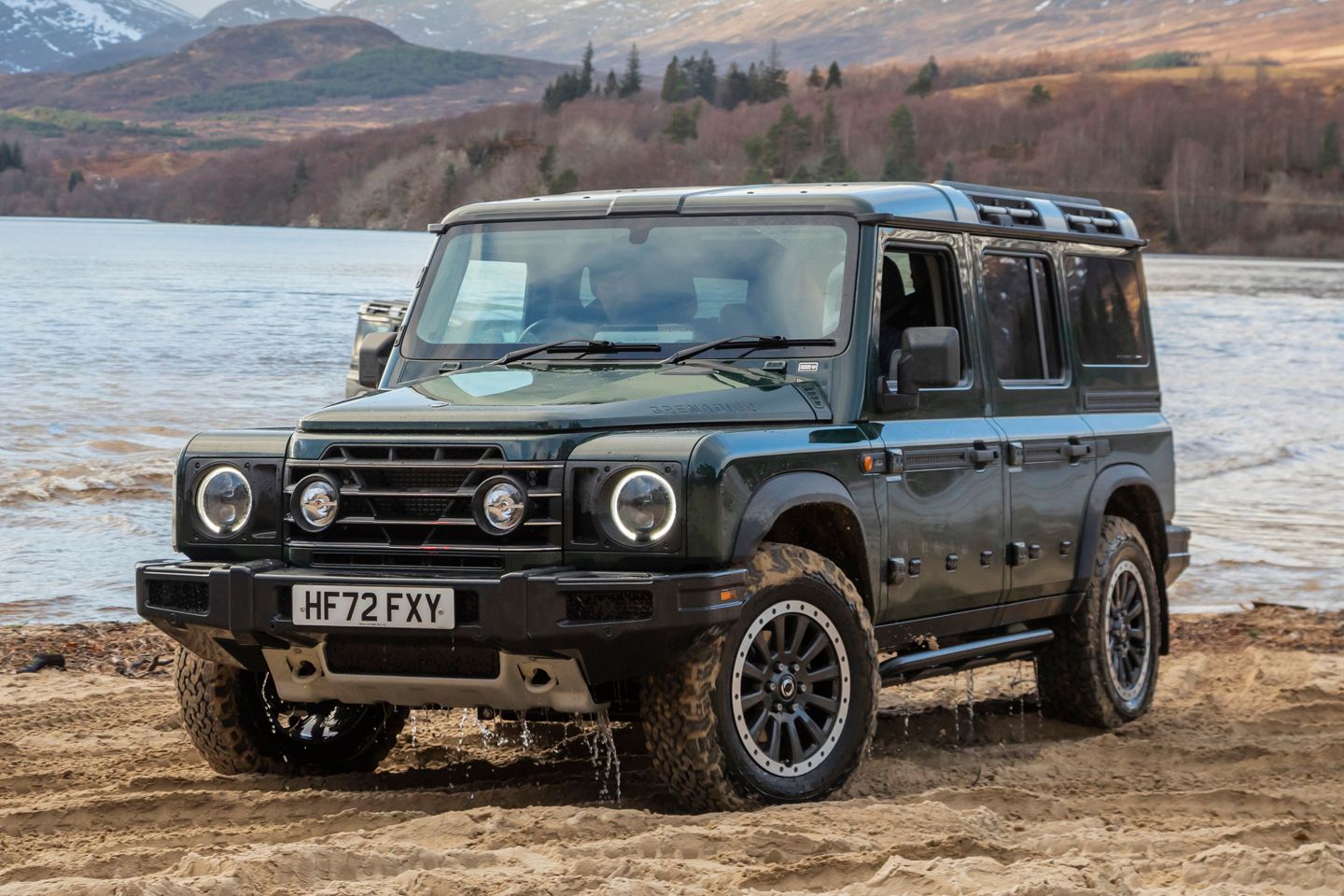
Key considerations
- Available for £37,000
- 3.0-litre inline-six petrol or diesel, all-wheel drive
- Old-school ladder frame 4x4 that’s better off the road than on it
- Loads of presence, and nicely integrated features
- Quite a few technical and customer support issues
- Arguably too expensive new, but that’s making them interesting used
First arriving on the show scene in 2020, four years after the demise of the old Land Rover Defender, the Ineos Grenadier was the new Defender for people who wanted an old Defender but who, on account of Land Rover stopping construction of the old Defender, could no longer buy an old Defender and who, if they were being totally honest, probably didn’t want an old Defender anyway.
Not many serial Landie owners wanted the new Defender either. They saw it as too posh and complicated, not to mention far too expensive. Nor did they like its level of electronic complexity that to them was just another way of saying costly repairs that could only be done by main dealers rather than by themselves or by backstreet bods in greasy flat caps.
Ineos’s boss Sir Jim Ratcliffe was the man to make the wistful dreams of a new/old Defender-U-Like come true. He had made inquiries with Land Rover about buying the rights to continue building the old Defender, but having been told to ‘do one’, he decided to make his own version that he would then name after a pub in London, as you do.

Ratcliffe played an active role in the design process. He reckoned that a car that was going to have mugs of tea rested on it didn’t need the nuanced, windtunnel-honed curves that would be brought by a conventional car designer. Instead he recruited Toby Ecuyer from the world of superyachts. Ecuyer had never designed a car before. Indeed, he didn’t start driving until the age of 30, but he was good at technical drawing and he understood the importance of extreme simplicity in achieving that classic 4x4 look.
Although the Defender was clearly the main driver for the overall design, Ecuyer and Ratcliffe took their inspiration from a huge range of vehicles, not just Land Rovers or other 4x4s such as Broncos and Jeeps but also lorries, military vehicles, Unimogs and tractors. Yes, tractors. The words pinned up on the boardroom wall were assured, robust, faithful, dependable and purposeful.
What came out of that design process was a combination of the old Defender’s utilitarian appeal and modern tech that immediately resonated with a lot of people, in particular fans and owners of the old Defender. By autumn 2020, 17,000 potential buyers had registered an interest in the Grenadier. a figure that supposedly increased to 50,000. Whether you believed that last one or not, it was all nicely ahead of expectations and on target for a plumptious annual sales figure of 25,000 units.
A new plant was built in Portugal for the construction of the chassis. Engineering teams were set up in Germany and Austria and there was a good deal of excitement about final assembly being carried out at a second new plant in South Wales. In the end, that never happened. Ineos bought the Smart factory in France instead, but let’s not get into the politics of that.
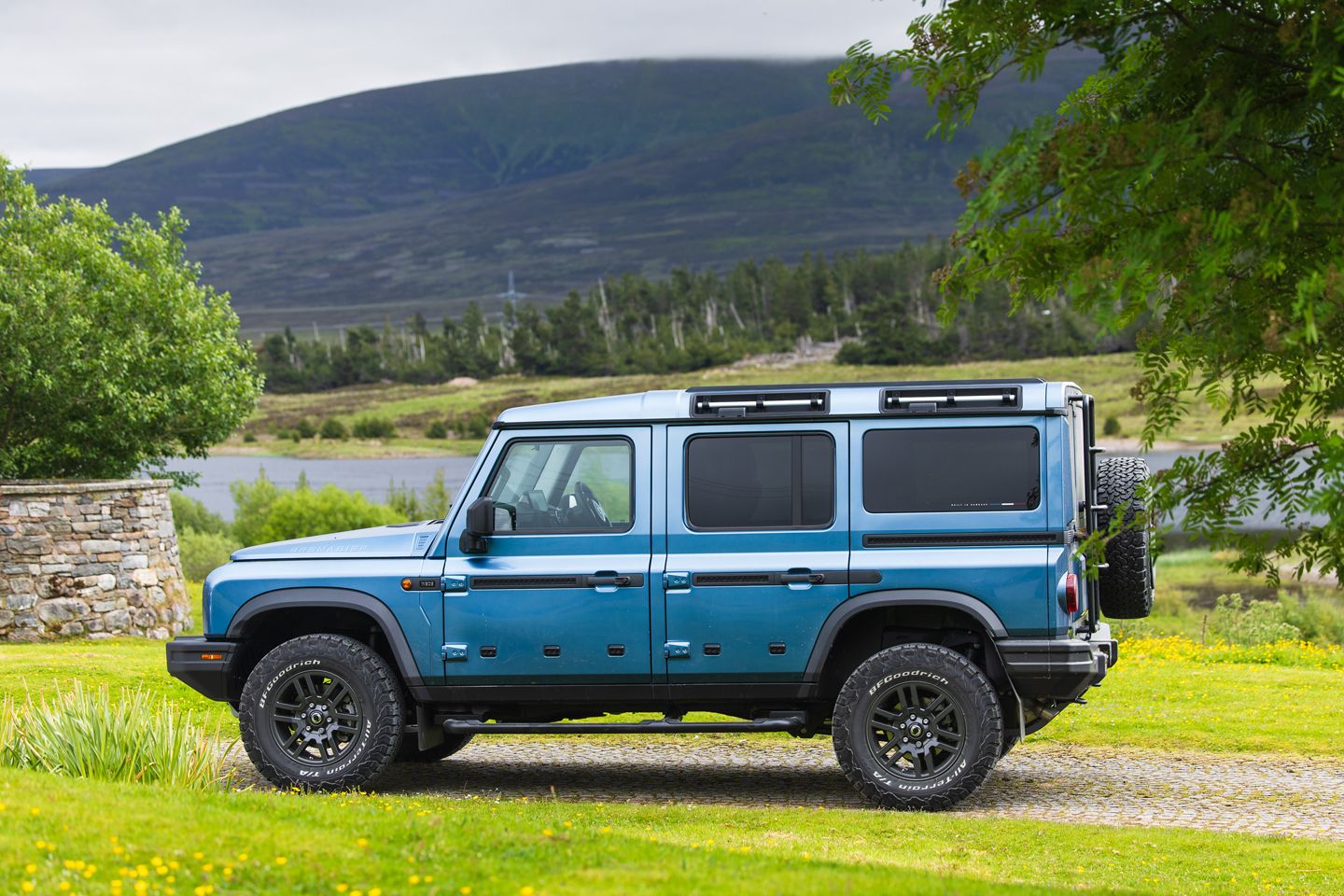
Grenadier production began in October 2022 with first deliveries in December of that year. Today, the range includes a five-seat Station Wagon, a five-seat Utility Wagon (with rear side steel panels instead of glass) or a five-seat Quartermaster long wheelbase pickup, all in Grenadier, Trialmaster or Fieldmaster trims. There’s also a two-seat Commercial in Grenadier spec at £63.5k.
What’s the difference between the specs? In brief, the Trialmaster stood for extreme off-road performance. It came as standard with a ‘Rough Pack’ (otherwise a £2.6k option) comprising diff locks, a snorkel air intake, BF Goodrich off-road tyres and a few other bits. The Fieldmaster, despite having the word ‘field’ in its name, was more about road comfort and refinement. It had a £1,725 ’Smooth Pack’ as standard, with front park assist, power/heated door mirrors, heated washers, a lockable centre stowage box, puddle lamps, ambient door lighting, auxiliary charge points and a compass/altimeter.
Although the specs and names might have seemed odd, the pricing structure for the five-seaters that we’ll be focusing on here was nice and simple. Every variant could be powered by a BMW inline six-cylinder 3.0-litre engine, burning either petrol or diesel. It didn’t matter which engine you picked, the prices would be the same spec for spec. The engines in question were the B58 282hp/332lb ft turbo petrol, as used in the Toyota Supra, and the B57 245hp/406lb ft twin-turbo diesel, as used (along with the petrol) in the 2016-on gen-seven 5 Series. They were slightly detuned in the Grenadier for longevity.
For an insight into the growth of petrol in a market which not that long ago would have been dominated by diesels, it’s interesting to note that of the 33 cars on sale in PH Classifieds at the time of writing in November 2025, 18 were petrols and 15 were diesels. That ratio wasn’t exactly mirrored by the Grenadiers on another well-known used car site, but it wasn’t far off it at 45 petrols and 49 diesels. The key US market wasn’t even offered the diesel version.

A new Grenadier in Trialmaster or Fieldmaster specs starts at a fiver under £70k, or a fiver under £65k for the basic (in the UK anyway) Grenadier spec. Grenadiers are quite rare still, with fewer than 15,000 thought to have been sold so far in the UK and maybe twice that number worldwide. After hoisting the new prices up year on year it seems that Ineos are now dropping them a bit. The new price in late 2022 was £66,000.
Today you’ll need £62.5k for a new Station Wagon but of course that’s before add-ons. The good news is that you can pick a used Grenadier up for well under £40k – more on that in the Verdict at the end – and there are plenty of examples to choose from too. But would it be a good buy, or a sign that it’s time to say goodbye to the dream of a new (old) Defender? Let’s take a look.
SPECIFICATION | INEOS GRENADIER (2022-)
Engine: 2,998cc inline six turbo petrol or 2,993cc twin-turbo diesel
Transmission: 8-speed auto, all-wheel drive
Power (hp): 282@4,750rpm (petrol), 245@3,250-4,200rpm (diesel)
Torque (lb ft): 332@1,750-4,000rpm (petrol), 406@1,250-3,000rpm (diesel)
0-62mph (secs): 8.8 (petrol), 9.8 (diesel)
Top speed (mph): 99 (petrol or diesel)
Weight (kg): 2,678-2,816
MPG (official combined): 17.3-19.6 (petrol), 21.7-26.9 (diesel)
Wheels (in): 17 or 18
On sale: 2023 - now
Price new: from £66,200 (£76,500 for Station Wagon)
Price now: from £37,000
Note for reference: car weight and power data are hard to pin down with absolute certainty. For consistency, we use the same source for all our guides. We hope the data we use is right more often than it’s wrong. Our advice is to treat it as relative rather than definitive.
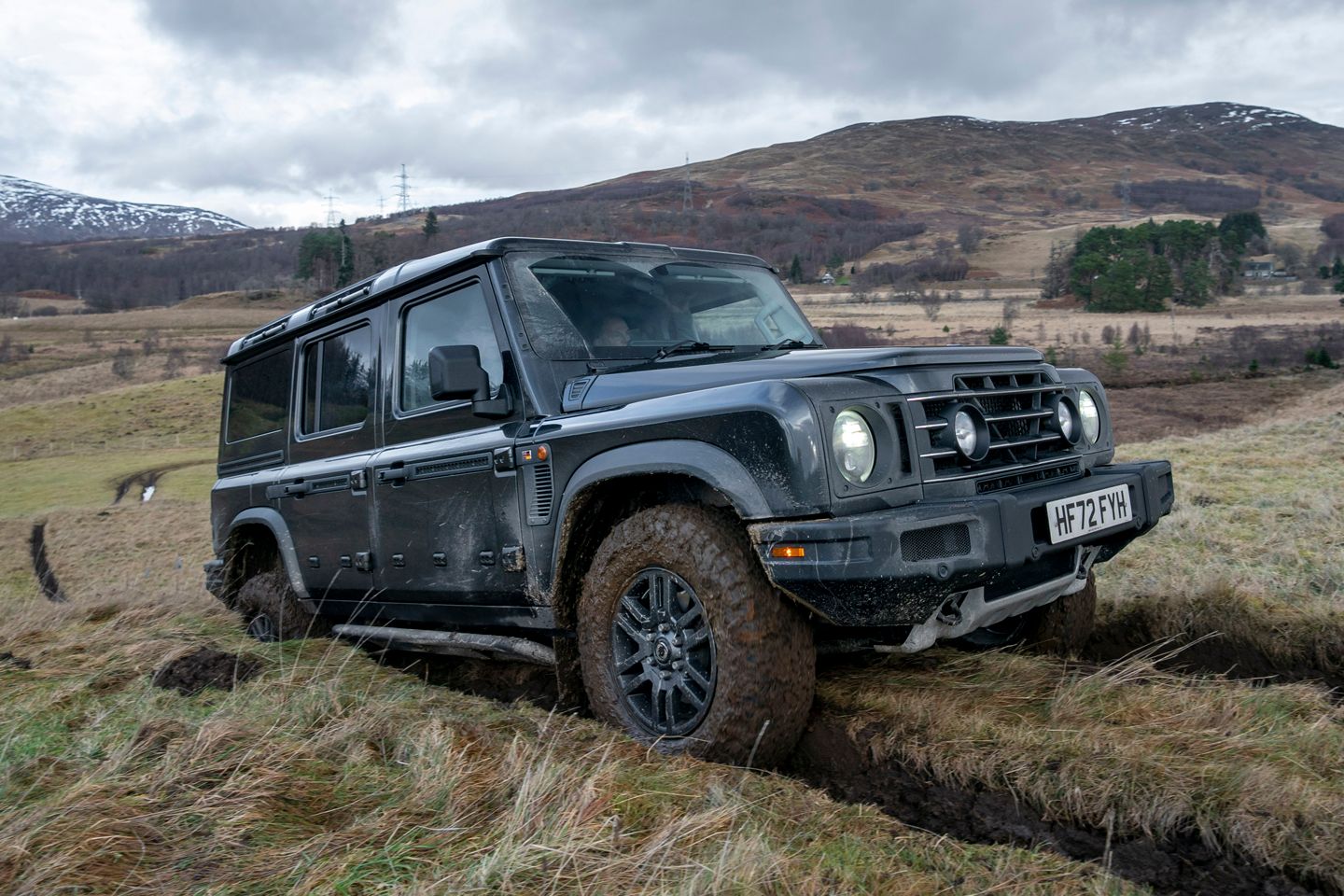
ENGINE & GEARBOX
BMW’s 3.0 petrol or diesel engines were connected to a ‘heavy duty’ ZF 8-speed torque converter auto, permanent all-wheel drive and a separate Tremec two-speed transfer case. Irrespective of the engine, most owners found the Grenadier to be more than powerful enough for daily motoring. The petrol felt quicker than the diesel, especially as you’d expect at higher revs, but in such a heavy vehicle (between 2.6 and 2.8 tonnes) neither of them were light drinkers. Even at cruising speeds, the fuel consumption of a petrol Grenadier would dip easily into the teens as the transmission smoothly shuffled through the gears in search of the best option to keep the plot moving.
In the diesel model, there was a slight delay between your foot pressing on the throttle and anything happening, but on the positive side with its extra torque it was happier to stay in top gear and return mpg numbers in the mid-20s. Still not spectacular, but thanks to the laws of physics there was no getting around the bulk of the vehicle, its teacup-friendly but aerodynamically inefficient bodystyle, or Ineos’s decision not to go hybrid.
In BMW applications, these B57 and B58 powertrains have done 300,000 miles or more without much trouble. Generically, some turbo hoses have leaked. It remains to be seen how they will cope over the long term with the effort of pushing this much weight around. So far there’s been no evidence of Grenadiers grenading but they have had their share of issues. Quite a few owners have complained to Ineos about their stop-start systems not working, with at least one of them receiving an unsatisfactory sort of ‘keep trying’ response. Funnily enough, some of those with correctly functioning s/s systems have said that they wished it wasn’t working as that would have saved them the bother of turning it off all the time. We understand that this issue has now been sorted on newer Grenadiers.

Some Grenadiers have exhibited vibration from a loosely attached airbox when drive was selected. Centre diffs have sometimes refused to engage or disengage. This has sometimes been put down to a loose clip connecting the cable to the shifter.
The mechanical warranty was five years/unlimited mileage in most markets apart from western and southern parts of Africa, where there was a 100,000km cap, which Ineos reckoned was 60,000 miles rather than the 62,000+ miles it actually was. Ineos was claiming ‘exceptional corrosion protection’ for the Grenadier. There’ll be a bit more on that in the Chassis section following this one. A separate three-year/unlimited mileage warranty applied to the paintwork, again, unless you were in a non-MENA African region when the mileage was capped at 100,000km. Australians got the best paintwork deal with five years of unlimited mileage cover.
Back on the mechanicals, as regards servicing we had a hard job taming the map on Ineos’s website but it looks like there are about 21 service centres in England and Scotland, one near Dublin, one near Belfast and, er, none in Wales. Hmm. Servicing is meant to be annual, but we can’t give you any hard and fast costs because there was no transparency on that from any of the service centres we looked at. Some of them were using the dreaded phrase ‘POA’. We can tell you that one PH owner was charged £460 for the second service on his diesel Grenadier, which is actually not too bad, so it’s not clear why the centres are being so coy.

CHASSIS
The Grenadier’s box-section ladder frame chassis was the result of a collaboration with Magna Steyr, who incidentally make G-Wagen frames. The chassis was e-coated and waxed on the inside and then powdercoated black (or red or grey if you didn’t mind shelling out an extra £945) on the premise that if you needed to do some extreme field repairs to it you could strip off the coating and welderup or whatever. It was certainly a heavily reinforced and meaty item, clearly built for endurance and longevity, which (with the best will in the world) was not a feeling you always got with the old, poorly rustproofed Defender.
Of course it’s early days yet, but online stripdowns have shown that other moving parts in the chassis like the propshaft and the axles (made by Carraro, better known for tractor parts) are every bit as chunky as the frame. This Brunel-like approach made the Grenadier heavy. Not quite heavy enough to make either version feel massively underpowered, but heavy enough to make you quite familiar with filling station forecourts. On the positive side, it was also heavy enough to show a trailer weighing up to 3.5 tonnes exactly who was boss. A reversing camera made light work of hitching up.
In terms of its behaviour on the road the ride quality was very good, but some reviewers damned the Grenadier’s dynamics with faint praise, comparing it unfavourably with ‘SUV offroaders’ like the new Defender. It’s a daft comparison really because a solid-axled, non-independently suspended, non-rack and pinion steered Grenadier is never going to drive like a thoroughbred on the road. It would stand up OK in comparisons against van pickups like the Hilux or D-Max, though maybe not quite so well against something like a Ranger.
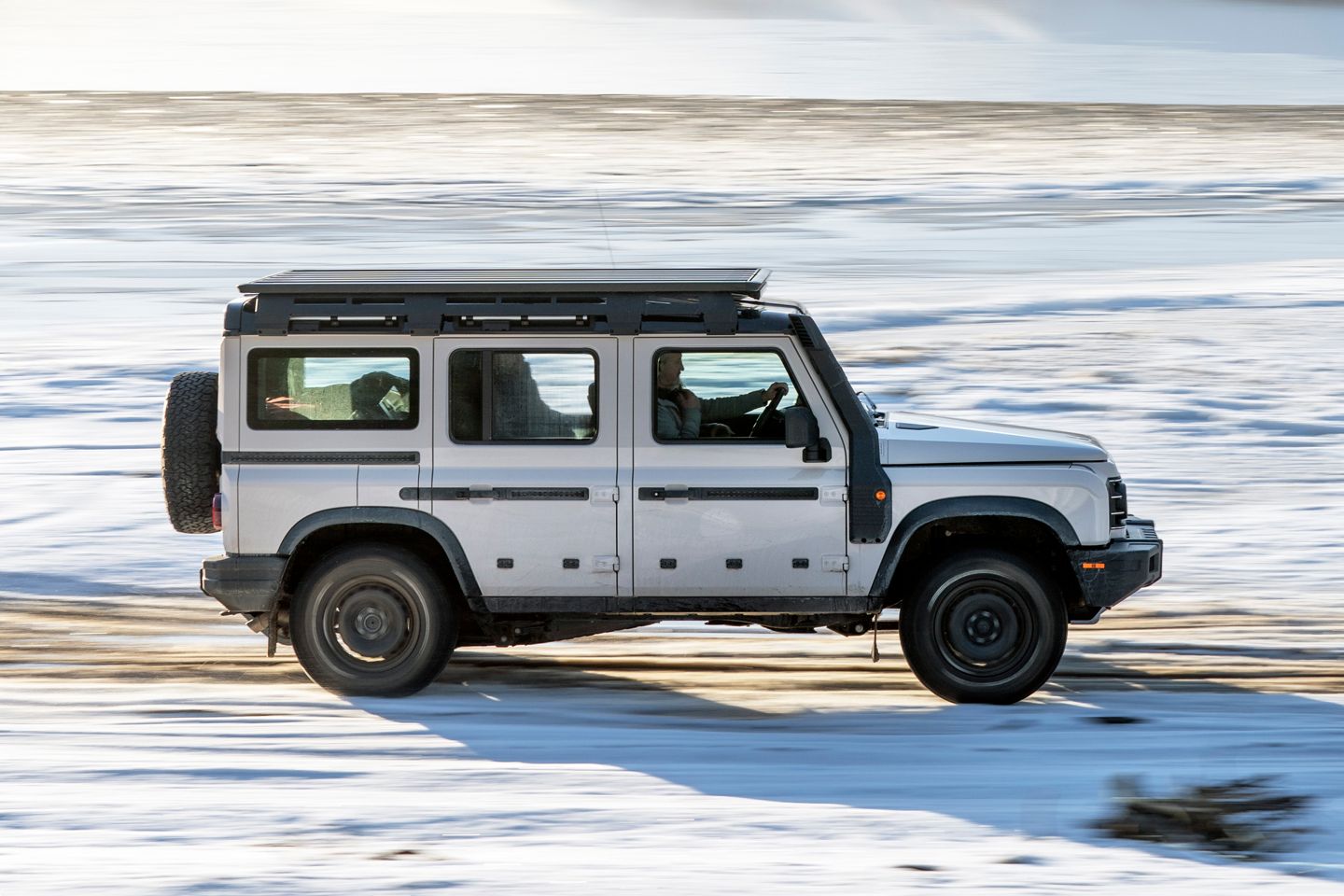
Front and rear axle diff locks were fitted as standard to the Trialmaster, and could be optioned on lesser models at £1,810 if you were planning on doing the Darien Gap and felt that you couldn’t manage without them. A hard-to-ignore grinding from the transfer case when changing from high to low ratios has been reported (and indeed heard) online. Some owners have wished that the Grenadier’s caster angle was different in hopes of cutting down on the wandering they’ve experienced when cruising. There’s a suggestion that the wandering could be down to imperfect wheel alignment. A smaller turning circle was another thing on some wish lists. There again, those who spent more time off the road than on it liked the Grenadier’s light and very low-geared steering (nearly four turns lock to lock) as it was well suited to mud and rocks, an environment in which the Gren acquitted itself well with enough articulation to get it past most obstacles.
17-inch steel wheels were standard. 17-inch alloys or 18-inch steelies added £855 to your bill. Diamond-cut 17-inch alloys were just under £1,500 a set or £1,690 in 18s. If your Grenadier didn’t have the Rough Pack, replacing the standard Bridgestone All-Terrain tyres with BF Goodrich, ones would cost just over £1,000. In hot weather, the pressures of the bigger tyres (that reportedly improved the steering) could increase to a point where the TPMS might start throwing warnings at you.
ABS rings were not particularly well shielded. There have been instances of both rings and sensors being damaged by flying stones, causing various dash warnings and a drop into limp mode. At least one owner suffering from this was told that it wasn’t covered by the warranty. Front brake flexis have been known to make contact with the tyres. Ineos was aware of that so this flaw has (we guess) been put right by now.
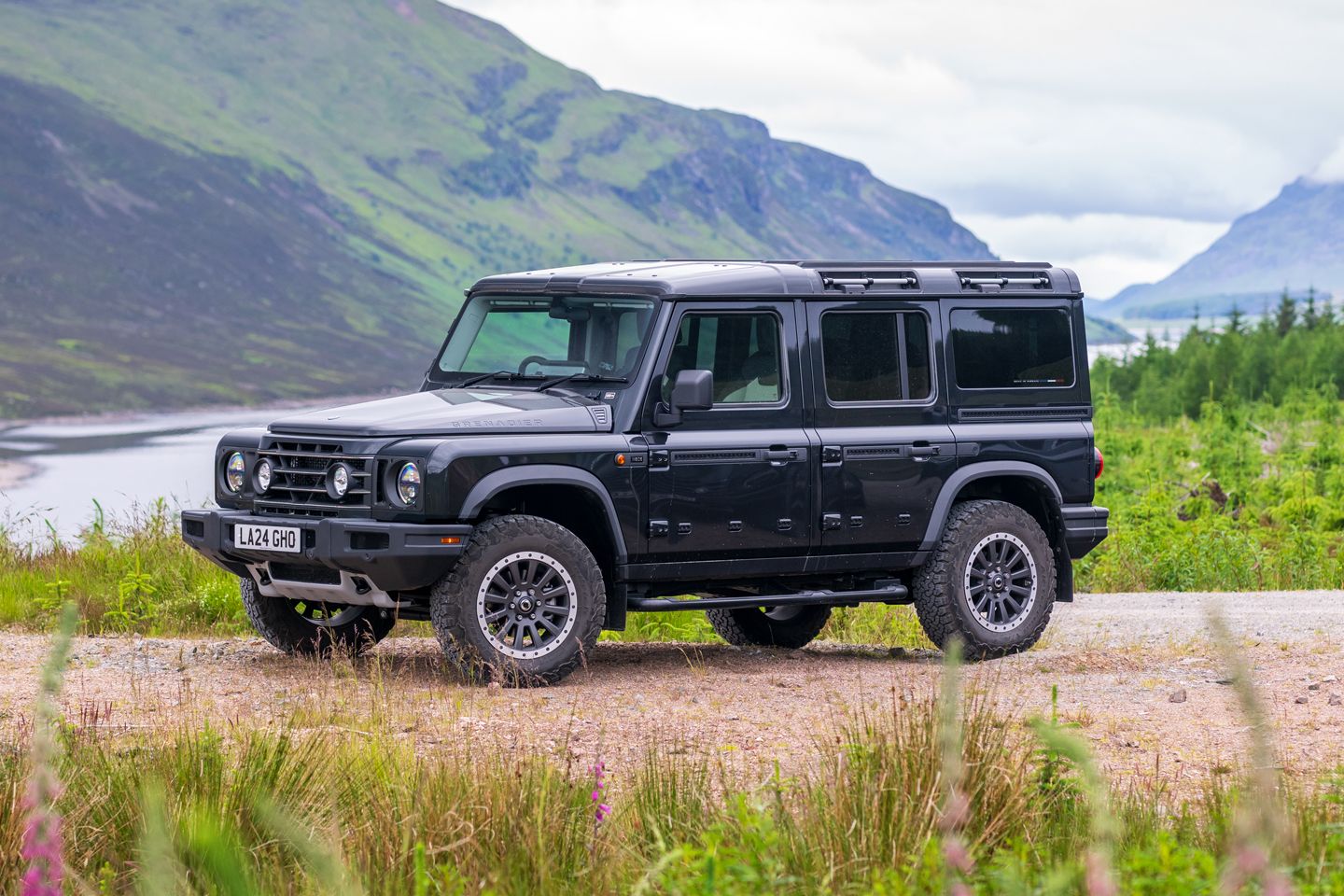
BODYWORK
Everything on the Grenadier looked flat, but in fact many of the panels and all of the glass pieces had curves to them. There was a choice of six solid or four metallic paints, Britannia Blue being the default free colour. Other solids were between £650 and £740, with the silver, blue, red or grey metallics costing £1,070. Having the roof painted in a contrasting white or black added another £2,000 to the bill.
External hinges were specified to simplify door removal, and a split back door design, one small and one large, was chosen to ease loading and unloading. With the benefit of hindsight Ineos was able to integrate into the design of the Grenadier many items that on a Defender would require an element of tacking-on. So you could have a front 5.5 tonne winch (£3,120) which sat neatly within the bumper; a roof that could take loads as it stood without the need for a separate rack; and pre-wired ‘utility rails’ running through the doors and below the rear side windows to allow lights and suchlike to be attached for camping or other purposes. Laudably, Ineos had an open-source attitude to aftermarket equipment manufacturers.
Although the Grenadier was less complicated on the electronics front than some cars of a similar ilk, many diehards thought that it could have been even simpler, thus lending itself more easily to quick and/or easy owner fixes and boosting its appeal as a self-contained, multi-continent overland tourer. An early promise by Ineos to supply hands-on owners with technical manuals and product diagrams hadn’t been fulfilled as of April 2025. This omission added delays to the mending of crash-damaged cars at insurance company-approved (but not Ineos-affiliated) bodyshops.

On the plus side, you’d have no bother fitting all your gear in or indeed on to a Grenadier for a multi-continent trip, with up to 2,000 litres of cabin space on hand. A standard Euro pallet would fit into the Grenadier Commercial. Ten tie-down rings were standard, but flush-fitting ‘utility rails’ running the length of the load space were a £225 option on non-Trailmasters. A range of barriers and partitions was available in the accessories catalogue. Safari windows were a £1,695 extra.
Tubular factory side steps have gone rusty in a very short time, having apparently very little protection from stone chipping. Some powered mirrors haven’t worked and windows could be squeaky when operated in wet weather. Faulty door locks and sticky buttons have caused the engine to pop back into neutral as a result of the car thinking that the doors weren’t shut.
There was a recall in March 2025 to stop insufficiently greased doors opening while driving. That recall affected cars built between July 2023 and April 2024. Sensors for the bonnet locks have gone squiffy too. Door seals have failed, allowing water ingress, and winches have stopped working. Front screens have developed stress cracks from the lower centre section of the glass.
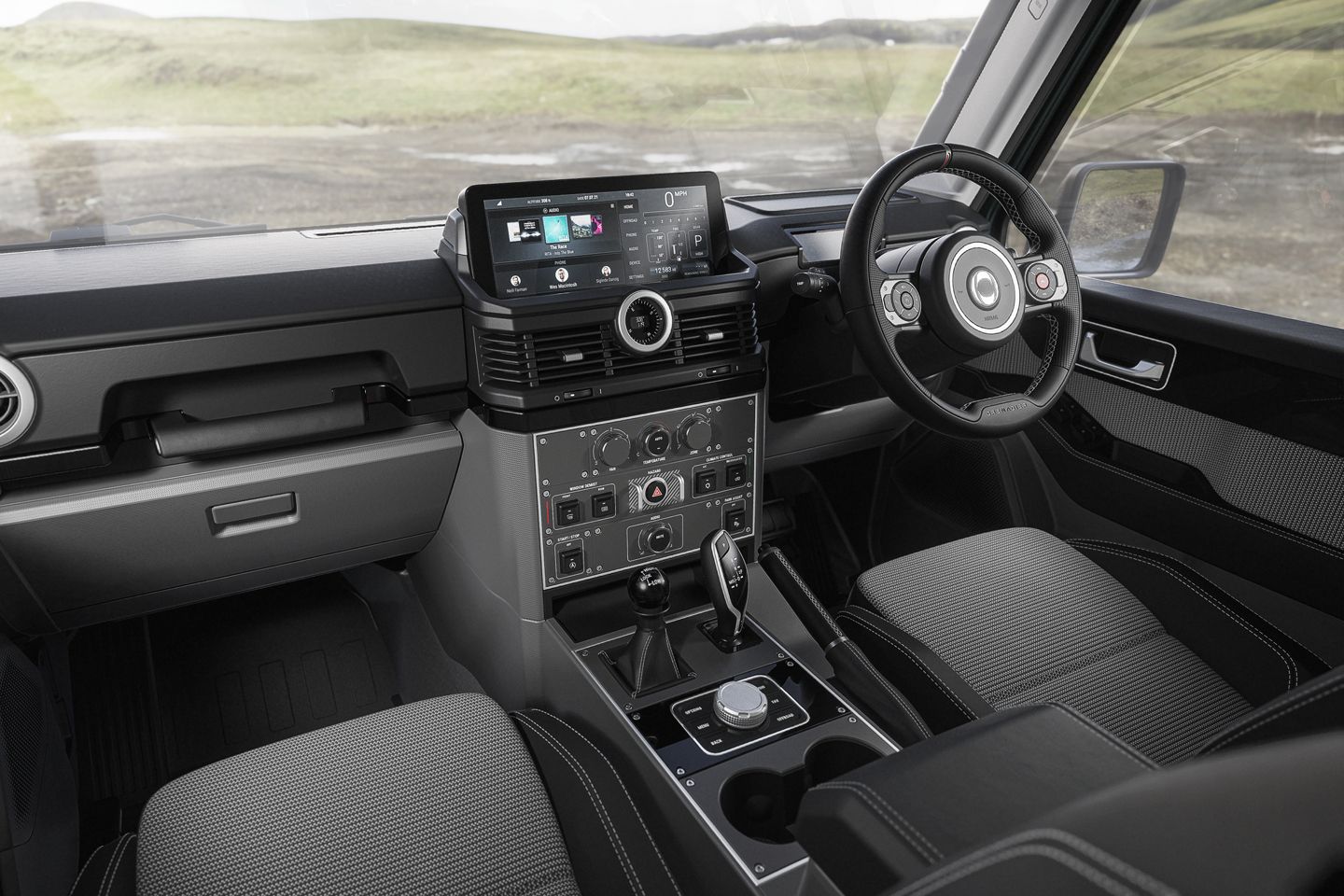
INTERIOR
Despite being perhaps a bit short on legroom in the rear, the Grenadier was a decent family car with a usefully square cargo space easily accessed by wide rear door opening angles. With the rear seats up you had over 1,150 litres of luggage space, but oddments storage wasn’t brilliant with small door pockets and a minuscule glovebox. The aftermarket has stepped in with some clever ceiling-mounted shelving systems.
The standard Grenadier came with a carpet-free floor with drain valves for hosing out. Leather was a £2k+ option for non-Fieldmaster 5-seaters or a little over £1,400 for 2-seaters. The presence of an elbow rest on the driver’s door was appreciated by those switching from Defenders. Visibility to the rear was a bit limited but ahead it was very good, making it easy to place the vehicle. The headlights were great too but the reversing light was weak, encouraging you to hook up an aftermarket LED to one of the pre-wired roof circuits.
Some owners of diesel cars have noticed fairly heavy vibrations through the steering wheel at idle. Forum posters have suggested this could be down to duff injectors or, in the case of one owner who had to have his transfer case replaced (not sure why), the possibility of overtightened engine mounts following reinstallation.
The heating and ventilation system wasn’t that sensitive, leading to a lot of small adjustments – a bit like driving a barge down a canal – until you got used to the feel of it, at which point it was capable of delivering a very toasty ambience. Having said that, getting the same temperature in the front and rear compartments has been problematic for some, with very cold air coming through the front vents while very hot air was coming through the backs. Leaking AC compressors have been reported.

Most owners seemed to get on fine with the central location of not just the infotainment screen and the speedo but also most of the minor controls, which were not just at the normal knee-high level but also above your head, aircraft-style. Not everyone got on with the angled rest pad for the left foot, a problem arising from the position of the exhaust on RHD cars. Modified replacement mats with smaller humps have now been produced by GrenX in Australia.
Over-bonging could be an issue, though with a bit of research you could reduce that. Various dash warning lights have been known to pop up, not always for an obvious reason. The power steering warning seemed to come up a lot. There have been actual hardware failures in that area, but fritzing by this item and by the winch and the diff locks has been attributed by at least one Ineos agent to a burnt-out terminal in an electrical box underneath the brake booster.
One 12v socket and two USB ports (one A and one C) were located in the centre console storage tray. If you wanted two USB ports in the rear that would cost you extra. DAB radio was standard, as were wireless Apple CarPlay and Android Auto. Some owners have been annoyed by the radio always coming back on when the car was restarted, with additional annoyance caused by them not knowing how to turn it off. The car’s main battery was housed under the rear seats to protect it. There was a dry storage area under there, too.
At least one online reviewer has described the level of build quality and finish, especially in the back, as shoddy for a car of this price. One Aussie owner complained about the £600+ quote he was given for a replacement ignition key, and the £550 he was told a replacement steel wheel would cost. He should be so lucky: PHer and Grenadier owner Lefty was told by someone that the steelies were £1,000 each in the UK. Gumph!
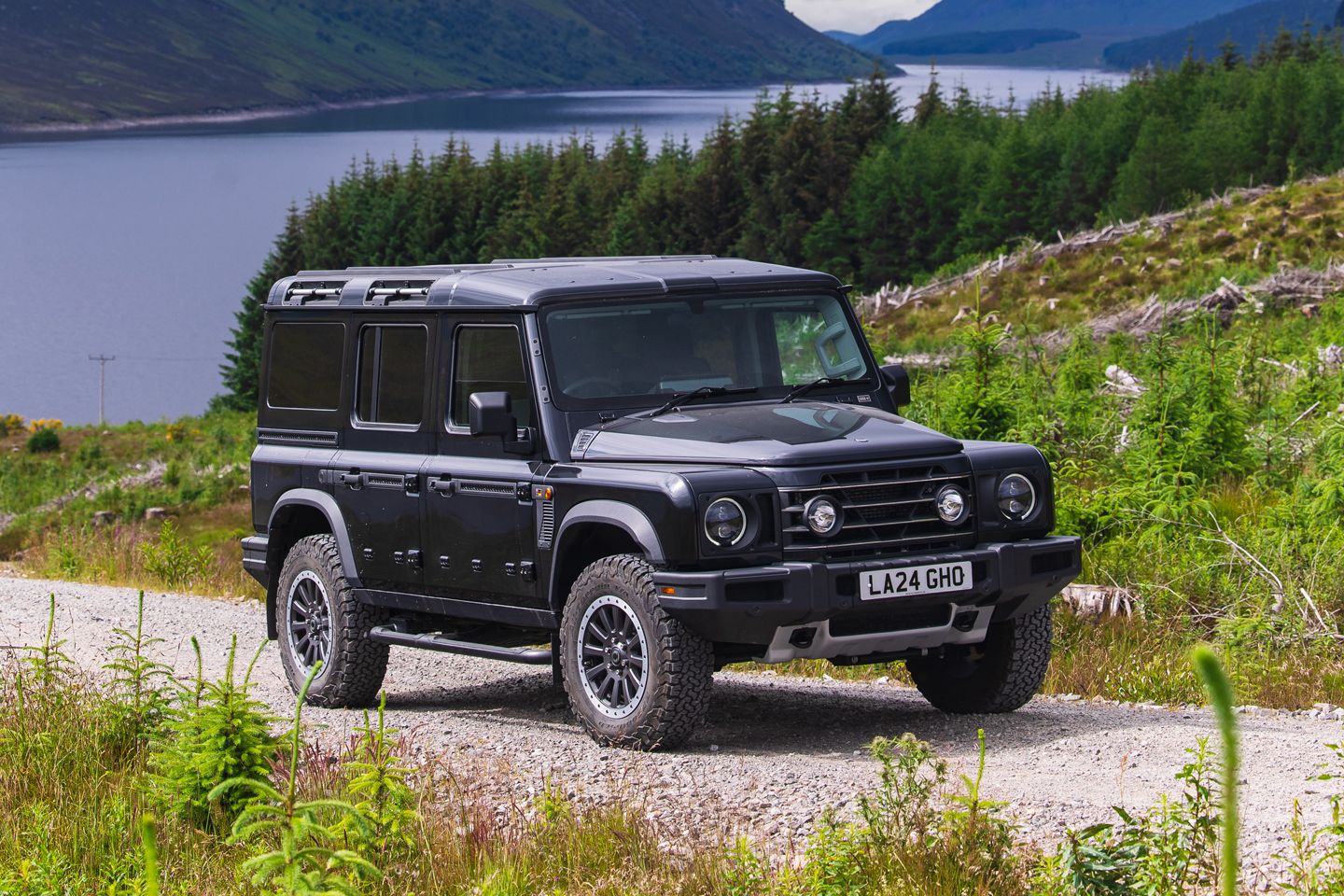
PH VERDICT
Some say that the Grenadier is what the old Defender should have been. Whatever your view on it, the Grenadier was a great idea. There was clearly a ready market for a new and improved Defender, and the names on the key components collab list – Magna Steyr, ZF, BMW, Tremec, Carraro – were all bang on for the job in hand. The finished product was brilliant for heavy-duty towing and, as long as you had confidence in your ability to fettle electronics should they go wrong, a valid choice for long-distance overlanding. The use of strongly built, traditional chassis components and well-proven powertrains was refreshing and reassuring. There were enough creature comforts to keep most people happy. The Grenadier also had real presence. It gave you a buzz when you marched up to it, and it was and still is regarded with benign curiosity by other road users.
It’s not been plain sailing though. Some of those who expressed an interest in the Grenadier or who placed an order for one pulled out after driving it, presumably disappointed by the on-road chassis dynamics. That was a misunderstanding of what the Grenadier was about. Perhaps the best way to get your head around the handling was to look at it as an off-road vehicle that could be driven on the road. Heaven knows that the old Defender could hardly be described as an inspiring drive.
There have been issues, not only with the vehicles in terms of faults, fit and finish and build quality, but also with the support which has been found wanting by more than a few customers. Parts supply hasn’t always been great either, and when parts were available some of the prices could be wincingly high. After a 5mph coming together with, would you believe it, a Defender, PHer Lefty faced a long wait for repairs before eventually being given a parts bill of £7,500 for the damage done to the front quarter of his Grenadier.
Some buyers were caught out on the taxation front after buying a commercial Grenadier with the decreased rear legroom and steel rear panels. Ineos said it was certified as a commercial vehicle, and apparently it was with the DVLA, but one owner said that the HMRC didn’t recognise it as such, making it impossible for him to reclaim the VAT or claim tax relief as a business cost. We’re not able to confirm or deny any of that, but it’s obviously important to check out stuff like minimum payload limits, light goods vehicle speed limits and insurance if this is the route you’re planning to go down.
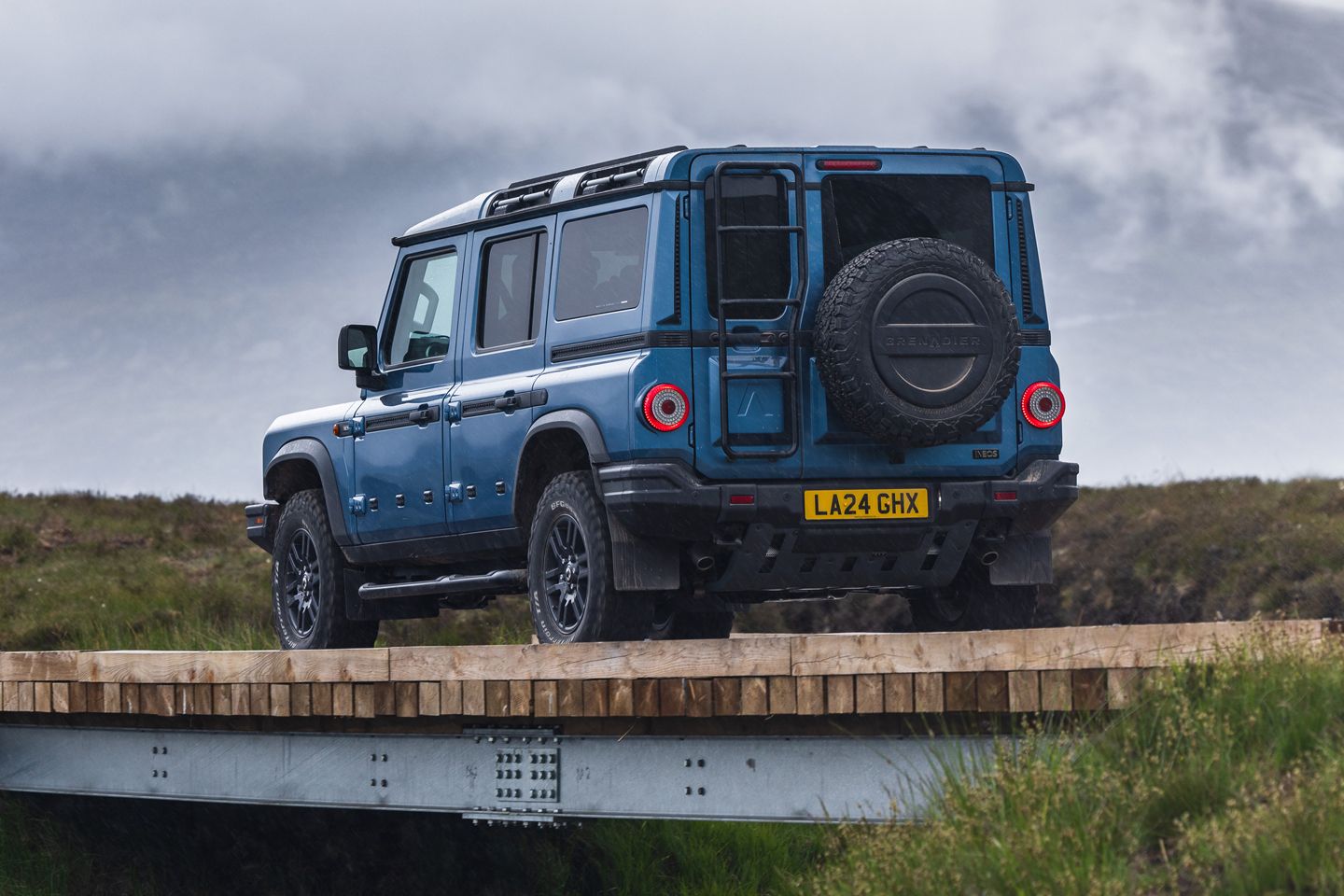
In fairness to Ineos, setting up a new car company can only be described as massively challenging. James Dyson pulled out of building electric cars after blowing £500 million of his own money, and even Land Rover, with all of its long experience, didn’t fancy the idea of rejuvenating its old Defender, so it’s hats off to Jim Ratcliffe for having a go. It’s thought that he was into it for over £650 million at one point, plus the prospect of legal action from JLR on trademark infringement. That never came to anything, but it just shows you the risks involved.
Fuel consumption might be an area of concern for some would-be owners, BMW’s ‘efficient dynamics’ having been relegated to the status of a distant memory in something this hefty. There’s no getting away from the fact that quite a few other vehicles will do everything a Grenadier will do, and more, but the Ineos does have a certain rufty-tufty, solid-feeling appeal, and you could also say that they’ve ended up being on point with their separate chassis design. Secondhand ones don’t look that expensive now, at least when you compare them to new ones.
Faster depreciation than normal is usually caused by a mixture of reliability issues, poor customer support, and a lack of perceived quality for the money. You could say that the Grenadier tripped up to a greater or lesser extent on all three fronts, but now it looks like many of the early Grenadier mistakes have been, or are in the process of being, rectified. Assuming that used cars have been properly sorted out under warranty, maybe this is actually a good time to buy one of those because it is entirely possible that Ineos goodwill is about to start trending upwards – though to make sure that happens, they will need to make good on their promises of improving quality and support and growing their network of service and main dealers.
In his excellent thread, Lefty mentioned that Ineos’s CEO has acknowledged that they did get the ratio of vehicle delivery to parts availability wrong, so hope springs eternal. For what it's worth, the most affordable Grenadier on PH at the time of writing (for non-VAT reclaimers at least) was this ’23 petrol car with 27,000 miles on it at a pound under £37k. If you can get the VAT back you can save a grand on that with this black example, also petrol, with just under 16,000 miles recorded.
Gen2 needed to sort the steering out and fix the niggles and maybe take some weight out of it so MPG isn’t as horrific. Makes a Defender appear frugal…
But I still have lots of want
Thought I'd save people time and get that in early.
Be interesting to see what global sales are actually like, as that's the real marker, not the UK. There is a dealer here in Jeddah and I do occasionally see them on the road, but they're not very popular.
Caveat Emptor seems to be the summary.
Some 24/25 cars have issues with noisy steering pumps that Ineos can’t seem to fix.
Some people who fit large suspension lifts and 35” tyres are breaking drivetrain joints.
Some people have had issues with sticking door buttons, mine hasn’t but a spray of silicone solves it apparently.
Some of the interior plastics are pretty s
 tty for what is an expensive car. That’s not where the development money went
tty for what is an expensive car. That’s not where the development money went 
Thought I'd save people time and get that in early.
Be interesting to see what global sales are actually like, as that's the real marker, not the UK. There is a dealer here in Jeddah and I do occasionally see them on the road, but they're not very popular.
The head lights and rear lights really ruin the looks for me.
I’m sure its a great car etc, I could of got on board if it was a British product.
But its just an ugly off roader to me.
Much prefer the old Defender, much prefer the new Defender.
Question is would I brave enough to buy one over a Toyota? New, probably not but second hand, definitely.
Have done 10,000 miles only since purchase (a very early one).
Truthfully, I have not been let down by this vehicle. Unlike a Defender I bought new, which had numerous break downs.
On road, it is not as direct as the Type R we have, but it is acceptable (from the factory the alignment could have been better - had this done virtually immediately).
As for build quality, I personally think it's superb, the paint on our Donny Grey version is exceptional. Yes, it was released with incomplete software, which was fixed shortly afterwards. Ineos to their credit, are fixing issues that have arisen through ownership (of which most you know very little about until the mechanics advise you of what has been done).
It's built like a tank with high quality parts: Recaro, Carraro, BMW, Tremec and ZF to name but a few. The platform, is ideal for modification and from the factory you can order it with all kinds of accessories for example a front winch and wired for a rear winch via a Nato plug.
In conclusion, I would recommend one, but you have to realise it isn't a Chelsea Tractor, although the company Chelsea Tractor will modify it for you.
For example in the first year (2023) which was a good year in the UK the figure is more like 840 TOTAL. Check the SMMT website.
My God Lefty is a prolific poster - I am guessing you are from Northern parts?
Neither old Defender or the Grenadier (nor many other ladder chassised small trucks) make ideal town or school run cars, no one should expect them to be.
Along with the G Wagen professional series (not the blinged up AMG versions) and 70 series LC's these are the last of the solid axle separate chassis rugged offroaders.
The only negative of a Grenadier being fuel economy - I think they are actually a bit overbuilt and the cabin being steel Vs aluminium of the original Defender doesn't help.
Along with the G Wagen professional series (not the blinged up AMG versions) and 70 series LC's these are the last of the solid axle separate chassis rugged offroaders.
The only negative of a Grenadier being fuel economy - I think they are actually a bit overbuilt and the cabin being steel Vs aluminium of the original Defender doesn't help.
Gassing Station | General Gassing | Top of Page | What's New | My Stuff




